Blog
AI Examples: Innovation in eCommerce
In the ecommerce industry, artificial intelligence (AI) stands as both a beacon of promise and a subject of debate. Amidst the flurry of speculation and grandiose predictions, a core truth emerges: the real value of AI lies in its practical application—solving tangible problems and enhancing the customer journey.
I had the privilege of participating in a panel discussion at Brave Bison’s recent Composable Commerce Summit in London, which delved deep into the practicalities of AI in the ecommerce industry with Kieran Lane, Director of Solution Engineering at Amplience, and Leigh Gammons, CEO at Tangent. This conversation was not about what AI might do in the future, but what it is doing now, and how businesses can harness its power responsibly and effectively.

Beyond the Hype: AI’s Grounded Potential in Retail
The panel kicked off with a unanimous agreement: the conversation around AI has been mired in hype for too long. We’ve all been to events where AI is portrayed as this all-encompassing force ready to revolutionize the world overnight. Yet, we leave these discussions with more questions than answers. This sentiment is not unique to those within the AI sphere but is a shared experience across various industries attempting to navigate the “new normal” AI landscape.
Antti Voutilainen, Director of Ecommerce at Finnish textile company Eurokangas, shared his experiences with AI tools that have had a tangible impact on their operations. “Amanda AI has been instrumental in managing our Google Ads account, making approximately 1.5 million adjustments monthly. It’s this blend of AI and data processing that has genuinely made a difference.” This example underscores AI’s potential when applied to specific, measurable tasks, including enhancing ecommerce site search, product recommendations, and category merchandising, which led to double click-through rates on product recommendations, and a 20% site-wide increase in conversions on mobile and tablet devices.
The Rise of Conversational Commerce
One of the most exciting developments in search and discovery is the advent of AI conversational commerce, exemplified by our own Moi AI. Initially met with skepticism, after ChatGPT took the world by storm, the tides turned with the broader acceptance of conversational AI as a trustworthy and useful tool. The paradigm shift was palpable. Suddenly, there was a recognition that conversational AI could significantly enhance the shopping experience.
A shift that was predicted by Mike Lowndes years ago in this Conversational Commerce report, and recently enhanced by the Gartner Report: How GenAI Impacts Digital Commerce Search & Discovery Experience (featuring Klevu, by the way!). Now, this shift is not confined to niche brands, but is being explored by giants like Walmart and ecommerce platforms like Shopify, signaling a readiness for the next wave of search and interaction innovation.
Key Questions for AI Providers
The journey to integrating AI into our operations is fraught with challenges, not least of which is the phenomenon of “AI washing” – the practice of misleadingly marketing products or services with the AI label without delivering substantial AI benefits. This concern underscores the importance of discernment, urging businesses to peel back the layers of marketing speak and assess the real value and ethics of AI solutions.

“If we think about how we actually operationalize AI capabilities within organizations. Because I think you write in, you know, breaking down what we’re actually doing. Are we using AI? Are we using machine learning? Are we actually just doing some basic automation and calling it AI?,” asked Leigh Gammons, CEO at Tangent.
The first step in cutting through the AI hype is to ask pointed, informed questions about the technology’s capabilities, maintenance, and ownership. Each question serves a critical role in understanding the substance behind the AI solutions offered.
- What does your algorithm do? – This question seeks to understand the specific problems the AI solution addresses and how it goes about providing its solutions. It’s essential to know whether the AI’s application is relevant to your business needs and whether its approach to problem-solving aligns with your company’s operational dynamics and customer experience goals.
- How do you maintain it? – AI systems are not set-and-forget tools. They require ongoing maintenance to ensure their algorithms remain accurate, effective, and free from biases that could skew their outputs. By asking about maintenance, businesses can gauge the provider’s commitment to the long-term viability and reliability of their AI solution.
- Is it your IP? – Understanding the intellectual property (IP) ownership of the AI technology is crucial for several reasons. It speaks to the authenticity and uniqueness of the solution, ensuring that you’re investing in genuine innovation rather than a repackaged tool with limited differentiation. Additionally, IP ownership can have significant implications for data security, privacy, and compliance, areas of increasing concern in the digital economy.
Beyond Capabilities: Ethics and Transparency in AI
The discussion around these critical questions naturally extends into the broader ethical considerations of AI in eCommerce. As I mentioned during the panel, it’s not just about what AI can do, but how it does it. Ethical AI usage concerns itself with transparency, accountability, and the avoidance of harm. This includes ensuring AI algorithms do not perpetuate biases or infringe on consumer privacy.

As AI becomes more prevalent, ethical considerations come to the forefront. Using behavioral data over demographic data to drive algorithms ensures our solutions cater to all consumers without bias. This approach emphasizes the importance of inclusivity in AI’s development and deployment. Now more than ever, there is an urgent need for ethical guidelines and guardrails to ensure AI is used responsibly, underscoring the importance of transparency and accountability in its application.
The call for transparency is not just about understanding the mechanics of AI but also about ensuring that these technologies are deployed in ways that respect consumer rights and societal norms. This transparency extends to data usage, with a need for clear communication on how customer data is utilized to train AI models, ensuring it aligns with legal standards and ethical practices.
Operationalizing AI: A Multifaceted Challenge
Operationalizing AI within a business is a nuanced endeavor that requires a careful balance between technological innovation and human intuition. It’s about putting in AI tools and ensuring they align with the business’s broader needs and values, a common challenge many retailers face. Internal enablement and education is essential, ensuring teams not only understand the tools they’re using but also trust them. This process is critical for businesses looking to integrate AI without disrupting their core operations.
Kieran Lane, of Amplience says, “AI is everywhere. Don’t focus on the tool, focus on the problem. I’m a solution engineer. I love speaking to customers. What are the challenges that you have today? Where are you going in the future? Tie that against your business objectives, your challenges, and the tool will, you’ll find the right tool. Engage your preferred outcomes. This could be taking away mundane tasks. Give your people more creative, more engaging, exciting things to do. Looking for ROI? It’s a marathon. Look at small incremental changes before that exponential growth. Build a mindset, and results will follow.”
AI should not just be about adopting the latest technology but about enhancing customer experience and operational efficiency. AI is not a strategy, it’s a tactic to meet a goal. A strategy that involves a continuous cycle of testing, learning, and adapting, ensuring that AI initiatives remain aligned with business objectives and market demands. I implore you to view AI not as a one-off project but as an integral part of your business’s evolutionary journey.
The Benefits of AI in Composable Commerce
The case of Paul Smith, a renowned fashion brand, offers insightful perspectives on embedding AI within by using composable commerce solutions.
The integration of AI into Paul Smith’s composable commerce framework was not merely about adopting new technology; it was about enhancing the customer journey in tangible, meaningful ways. By leveraging AI for search and personalization, Paul Smith could offer more relevant, engaging content and product recommendations, thereby improving the shopping experience and ultimately driving higher conversion rates and 74% more search revenue.

AI implementation within a composable framework allowed for greater agility and flexibility. As consumer behaviors and market trends evolve, Paul Smith can now more easily adjust its AI strategies, test new algorithms, and incorporate additional technologies without overhauling its entire eCommerce system. This adaptability is at the heart of composable commerce, ensuring businesses can stay ahead in the fast-paced retail environment.
Like Paul Smith, other retailers need to think more like a product team in composable. What’s your three month product plan? What’s your 12 month plan? What’s your product roadmap? Where can I plug AI into that to make our lives easier? Where does AI fit into our product roadmap to get the outcomes we are seeking?
Antti also brought up a really good point. “In composable commerce, use APIs as much as possible, then you can change things quite fast and be agile about things. Also, pick the right partners that kind of fit your size or are similar size to you. With Klevu, we also have a voice in developing the systems, and they listen to us.”
A Look Ahead
With AI, there are many practical realities and so much potential in eCommerce. Move boldly beyond the hype, focusing on tangible benefits, and approaching AI with a critical, ethical lens. As we look to the future, the lessons shared underscore the need for businesses to adopt a strategic, informed approach to AI, one that prioritizes customer experience, operational efficiency, and ethical considerations.



